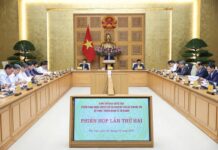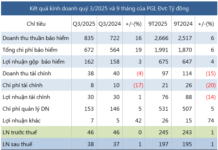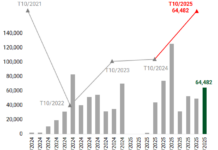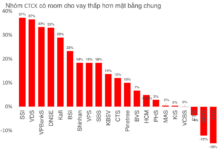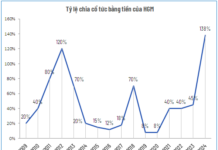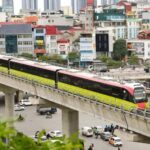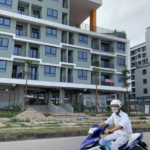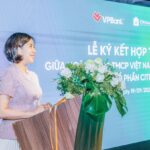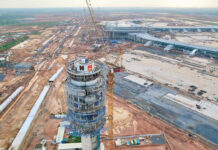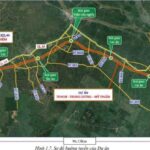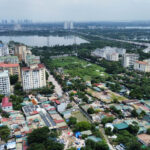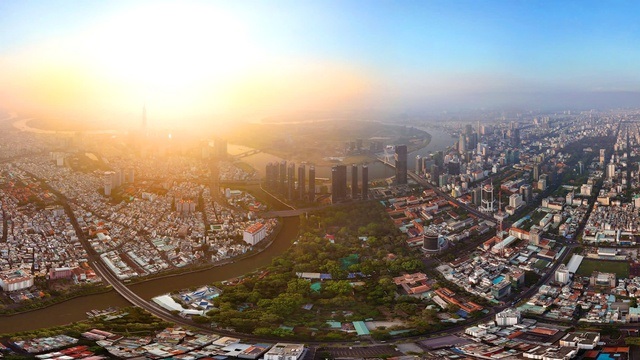
The merger of Ho Chi Minh City with Binh Duong and Ba Ria – Vung Tau provinces marks an unprecedented milestone in Vietnam’s urban development history. This strategic consolidation is set to redefine the region’s economic and social landscape. Photo: Lê Toàn
|
Following the merger, the total area of Ho Chi Minh City will expand to 6,773 km², accounting for 2.04% of Vietnam’s total land area. This expansion will facilitate the planning of an integrated urban region. The new population is estimated at 13.608 million, representing 13.4% of the national population (101.344 million). The labor force is expected to reach approximately 7.281 million, or 14% of the country’s total workforce (51.806 million). This substantial human resource pool will significantly boost industrial and service development in the Southern Key Economic Region.
Economically, the merged city’s GRDP is projected at around 2,971 trillion VND (equivalent to 120.8 billion USD), contributing 23.6% to the national GRDP. Excluding oil and gas revenues from Ba Ria – Vung Tau, the figure remains impressive at over 2,821 trillion VND, or 22.3% of the national total. This highlights the economic prowess of the new Ho Chi Minh City, a synergy of three dynamic economic zones. The per capita GRDP stands at 198.1 million VND (approximately 8,244 USD), 1.74 times higher than the national average. Even without oil and gas, the average per capita income remains robust at 187.4 million VND, 1.64 times the national average.
In terms of fiscal contributions, the city will contribute 681 trillion VND to the state budget, or 33.4% of the national total, while its budget expenditure is 237.5 trillion VND, or 10.4% of the national total. This underscores the city’s critical role in the national fiscal framework.
Foreign trade activities are equally vibrant, with total import-export turnover reaching 179.3 billion USD, or 22.8% of the national total. Exports are valued at 89.4 billion USD, and imports at 89.9 billion USD. The city’s total social investment capital is 631.8 trillion VND, or 17.1% of the national total. Retail sales of goods and services amount to 1,683 trillion VND, or 26.3% of the national total, reflecting strong purchasing power and a well-developed distribution network.
The draft report emphasizes that the merger of Ho Chi Minh City with Binh Duong and Ba Ria – Vung Tau provinces is a historic turning point in Vietnam’s urban development. It opens up opportunities for market expansion, increased investment attraction, infrastructure connectivity, production chain integration, and enhanced international standing, as well as access to advanced technology and financial resources.
This comprehensive restructuring of the development space brings together three of the country’s most dynamic economic hubs, with a new vision to create a “global-standard super city” in Southeast Asia, aiming to be among the top 100 most livable cities worldwide. This ambitious goal is designed to pioneer, lead, and drive national development. By leveraging the strengths of these leading localities, the merged entity will form a highly complementary administrative and economic unit, restructuring the development space under the concept of “one center, three regions, and one special zone.” This optimization will maximize the comparative advantages of each region, fostering a multi-centered super city along three corridors, supported by five pillars: industrial and logistics centers, international financial hubs, tourism and cultural industries, and education, healthcare, and science and technology centers.
However, the draft report candidly acknowledges significant challenges, including inadequate infrastructure, a shortage of high-quality human resources, environmental pollution, and widening income disparities. Additionally, the city faces competitive pressures in attracting investment, adapting to climate change, ensuring energy and cybersecurity, and preserving cultural and social identity. To address these issues, the city must transition to a new growth model and enhance its competitiveness through flexible and effective solutions.
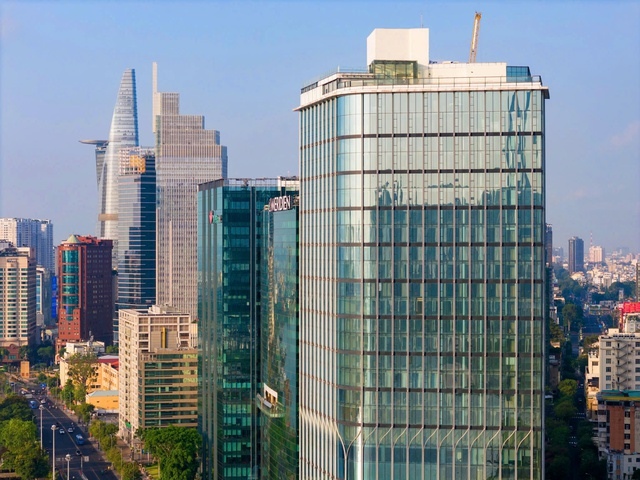 Driving Ho Chi Minh City’s development through strategic breakthroughs in science, technology, innovation, and national digital transformation. Photo: Lê Toàn |
Driving Development Through Science and Technology Breakthroughs
The draft report outlines a guiding principle for the upcoming term: unwavering adherence to Marxism-Leninism, Ho Chi Minh Thought, and the inseparable link between national independence and socialism. It emphasizes the creative application of the Party’s platforms, policies, and resolutions, as well as state laws, to practical realities. The report calls for the integrated and synchronized implementation of political tasks, with economic and social development, environmental protection, Party building, cultural development, national defense, security, and international integration as key priorities.
To propel the city’s development, the report highlights strategic breakthroughs in science and technology, innovation, and national digital transformation. It also emphasizes ensuring energy security, advancing education and training, and enhancing public health protection and care.
The city aims to seize every opportunity and mobilize all resources to emerge as a leading economic, financial, technological, service, educational, and healthcare hub in Southeast Asia and Asia. It aspires to become a major transportation and logistics center, meeting international standards for a smart, modern, and sustainable urban environment.
Crucially, the report underscores the central role of the people in all policies and strategies of the Party and local government, with their happiness and satisfaction as the ultimate measure of the political system’s effectiveness.
Efforts will be intensified to build and rectify the Party, enhancing its leadership capacity, governance, and combat strength. The focus will be on creating a leaner, stronger, more efficient, and effective local government apparatus dedicated to serving the people.
In terms of development goals, the draft aims to build a clean and strong Party organization and political system. It seeks to further refine the organizational structure of the political system, fostering unity, dynamism, creativity, and a pioneering spirit to lead the nation into a new era of development.
All resources and potential will be harnessed to drive rapid and sustainable economic and social development, leveraging advancements in science, technology, innovation, and digital transformation. By the 100th anniversary of the Party’s founding in 2030, the city aims to become a civilized, modern, and innovative hub, leading the nation’s industrialization and modernization efforts. It aspires to hold a prominent position in Southeast Asia, rank among the top 100 global cities, and achieve high-income status with a world-class innovation ecosystem.
Looking ahead to the 100th anniversary of the nation’s founding in 2045, the city envisions itself among the top 100 best cities globally, embodying the stature of an international super city in Southeast Asia. It aims to be a leading center for economics, finance, tourism, services, education, and healthcare in Asia, attracting global attention. The city strives for distinctive and sustainable economic, cultural, and social development, high quality of life, and deep international integration.
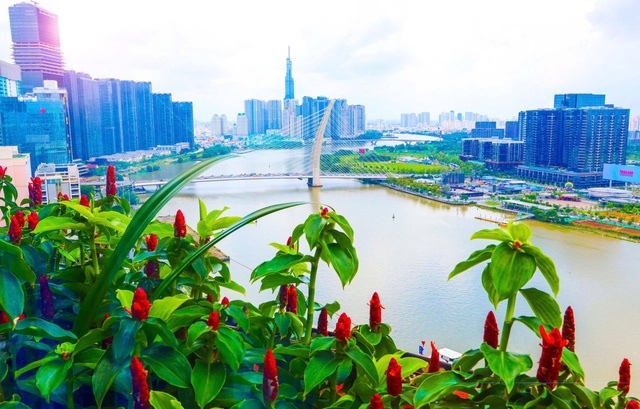 For the 2025–2030 period, Ho Chi Minh City targets an average GRDP growth rate of 10–11% per year. By 2030, the per capita GRDP is expected to reach 14,000–15,000 USD. Photo: Lê Toàn |
Key Objectives
For the 2025–2030 period, Ho Chi Minh City sets an ambitious economic target of achieving an average GRDP growth rate of 10–11% annually. By 2030, the per capita GRDP is projected to reach 14,000–15,000 USD. Total social investment capital is expected to average 35–40% of GRDP over five years. The contribution of total factor productivity (TFP) to GRDP growth is targeted at 60%. The digital economy is anticipated to account for 30–40% of GRDP. Total social expenditure on research and development (R&D) is set to reach 2–3% of GRDP, with at least 4–5% of the annual budget allocated to science, technology, and digital transformation. The average annual labor productivity growth rate is aimed at 8.0%.
In the social sector, the city strives to achieve a Human Development Index (HDI) above 0.8. By 2030, it aims to provide 35.1 hospital beds, 21 doctors, and 35 nurses per 10,000 inhabitants. The goal is for 100% of the city’s population to undergo at least one health checkup annually. By 2030, the target is for 40% of kindergartens, 45% of primary schools, 50% of lower secondary schools, and 38.5% of high schools to meet national standards. Health insurance coverage is expected to exceed 95%, and social insurance participation is targeted at 62% of the working-age population. The city aims to eradicate poverty by 2030, as defined by the city’s poverty line.
In urban and environmental development, the city targets a transportation land ratio of 16–26% of urban construction land. By 2030, urban wastewater collection is expected to reach approximately 80%, with 40–45% of collected wastewater treated to meet standards. Over 90% of household waste is to be recycled or treated using new technologies. Forest cover is to be maintained at a stable 11%. By the end of 2030, an additional 199,400 social housing units are to be constructed, and efforts will be made to relocate 50% of canal-side houses (20,000 units) within the city.
In defense and security, the city aims to achieve 100% annual military conscription, building a revolutionary, regular, elite, and modern local armed force that is comprehensively strong and exemplary. It targets a minimum 5% annual reduction in social order and traffic safety crimes, as well as in fires classified as Level III or higher. The goal is to achieve a 50% drug-free rate in wards and communes, with 100% of wards and communes free from complex drug issues, working towards controlling and eliminating drug crimes and addiction from society.
In Party building, the city aims to increase the proportion of grassroots Party organizations rated as good or better each year, reducing the rate of underperforming organizations to below 0.5% annually. It seeks to ensure that 100% of Party leaders set a good example through their actions. Annually, over 90% of Party organizations and members are to be rated as good or better. New Party member recruitment is targeted at 3–4% of the total membership from the previous year-end. The city plans to inspect and supervise 100% of Party organizations and members according to programs and plans, ensuring 100% follow-up on inspection and supervision conclusions. All Party organizations are to effectively implement digital transformation, with each affiliated Party committee developing at least one “Skilful Civic Engagement” model annually and at least 50 models replicated during the term.
Anh Thơ
– 15:47 24/09/2025
PwC: 89% of Vietnamese Businesses Plan to Commit to ESG Within the Next 2–4 Years
This insight is revealed in PwC Vietnam’s newly released 2025 ESG Practices Progress Survey Report, highlighting a distinct shift among Vietnamese businesses from awareness to action in the areas of Environment, Social, and Governance (ESG).
The Priceless Prestige of Diamond Sky in the Real Estate Market
In the realm of luxury real estate, the adage “Location is destiny” rings true. It’s not just a property; it’s a lifestyle defined by its surroundings. The right address can elevate your everyday living, offering unparalleled convenience, exclusivity, and a connection to the pulse of the city or the serenity of nature. This is where your story begins, and where your legacy takes root.
Revolutionizing Finance & Real Estate: Citics and VPBank Partner to Build a Digital Ecosystem
On September 19, 2025, in Hanoi, Citics Group Joint Stock Company (Citics) and Vietnam Prosperity Joint Stock Commercial Bank (VPBank) officially signed an expanded cooperation agreement, marking a strategic milestone in combining financial and banking strengths with real estate technology expertise.









